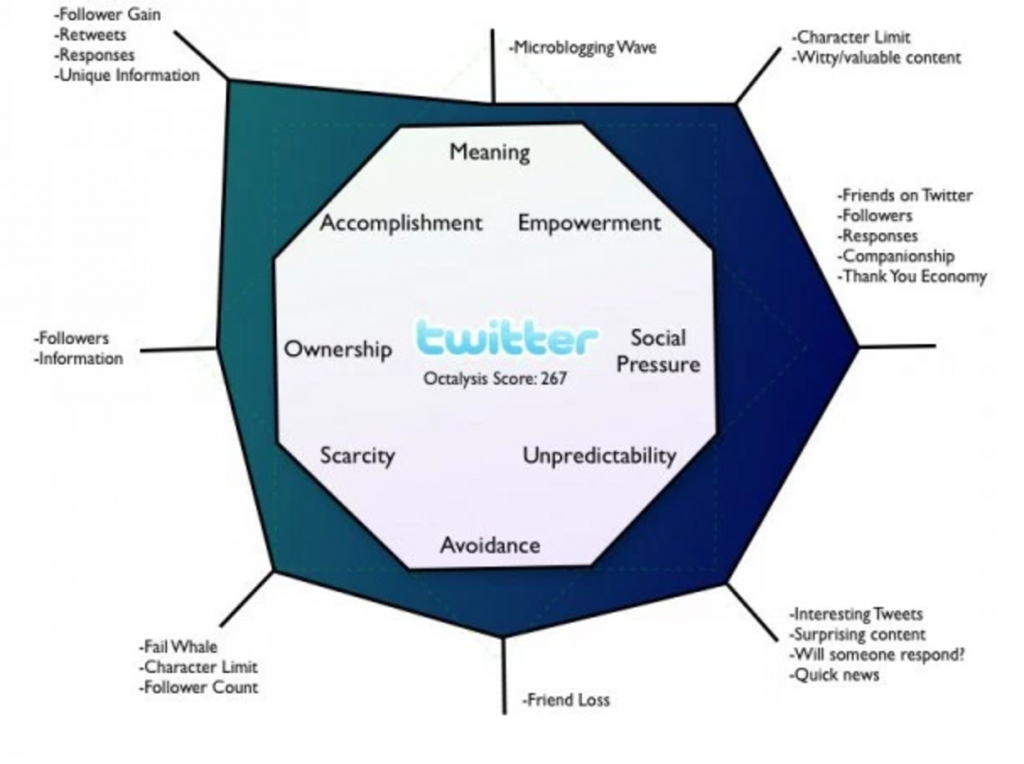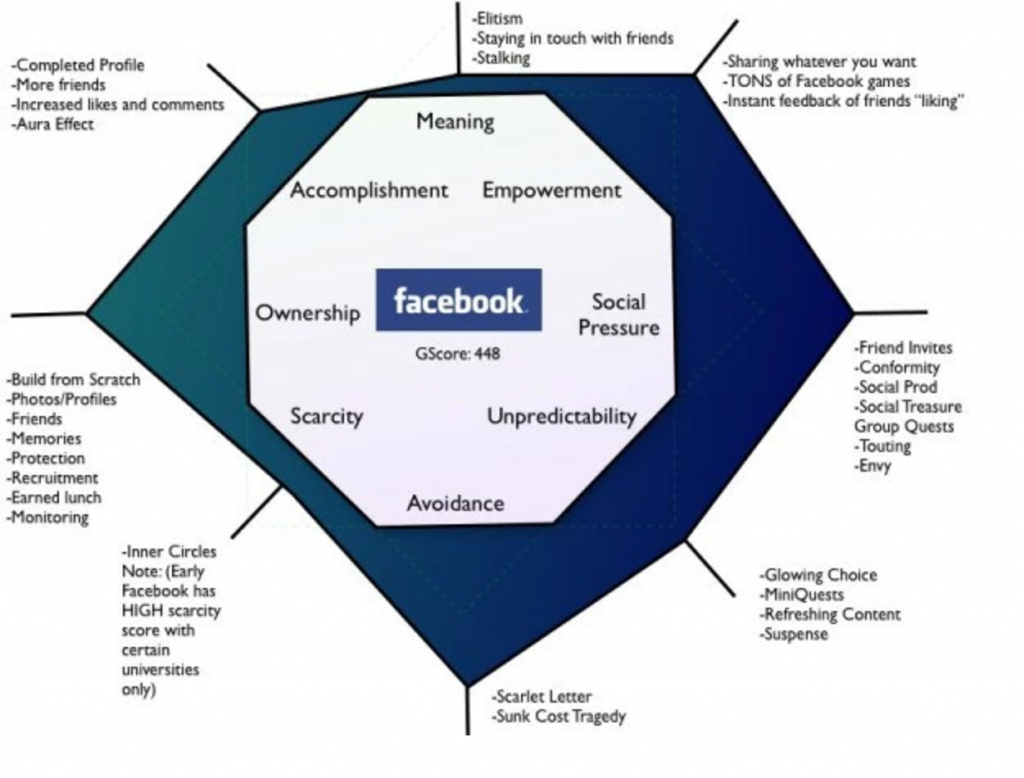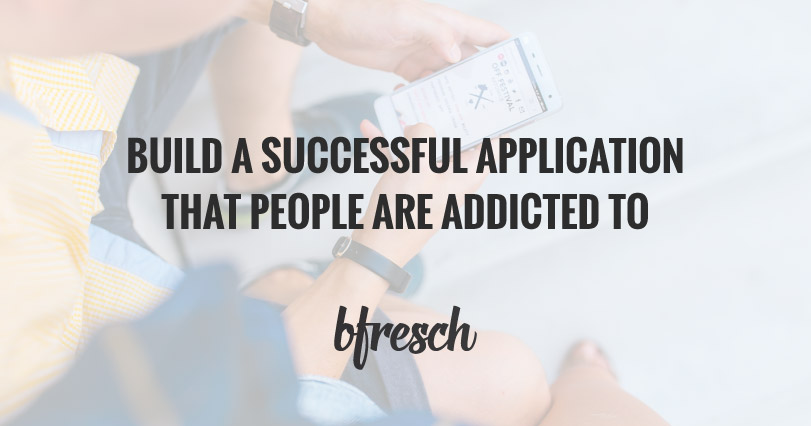Most of us today have our favorite applications we use every day. We look forward to using it when we can and sometimes we even have a hard time shutting it off. As a UX designer, I was curious, why do people like these applications so much? How can I learn from them and apply it to my own work? This is when I found something called The Octalysis that was built and explained by Yu-kai Chou one of the top author’s in gamification. In this post, we will get into what the Octalysis is and how it plays a part in the addiction of successful applications.

First I want to talk about some of the most popular applications downloaded according to Apple in 2016. Here is their list:
- Snapchat
- Messenger
- Pokémon GO
- YouTube
- Google Maps
- Pandora
- Netflix
- Spotify Music
For me personally, I am addicted to Netflix, Spotify Music, Google Maps, and YouTube. I have learned that I am addicted to these applications for different reasons. The biggest thing to understand before we dive into Gamification and The Octalysis is knowing that different people have things that motivate them. It is something that makes us different as humans and give importance to understanding the target audience/personas you are trying to reach out to.
What is Gamification, How It Relates To Applications
Gamification is the craft of driving all the fun and addicting elements found in games and applying them to real-world or productive activities. This is what Yu-kai Chou calls “Human-Focused Design”, which is a design process that optimizes for the human in the system, as opposed to the pure efficiency of the system or what Yu-kai Chou refers to as “Function-Focused Design”. The general concept is when you design something for people don’t get wrapped up in the functionality that comes second to how people feel about it first. Focus in on one person that is a perfect match for the applications you’re building, tailor your applications to them.
Most systems are created with “function-focused” design that is meant to get the job done efficiently. However, this is assuming that people WILL, in fact, do their job. It doesn’t factor in the human side of the equation showing that we have feelings, or insecurities why or why we don’t want to do something. People are not forced to play video games we want to play video games, some of us think about it all day long, “Man, I can’t wait to get home from work so I can play X”. Sound familiar? Gamification is called gamification because the gaming industry was the first industry to really master “Human-Focused Design”. I would even bet that most of you if not all of you can name a game that you have invested 10-20-100 hours into at one point in your life.
This is the type of addiction I am obsessed with, I want to create this type of addiction in my work. In order to zoom in on where this addiction lies Yu-kai Chou created this framework for harnessing Gamification for other industries.
The Octalysis Tool Helps Build A Successful Applications
The Octalysis is a tool that display’s the eight core drive of human motivation. This tool helps designers place functionality and design elements alongside these eight core drives. To sum it all up, The Octalysis defines what areas of motivation your system is strong or weak in.
Let’s take a look at Twitter’s and Facebook’s Octalysis.

Twitter, obviously is really strong in the social core drive of motivation but if they wanted their application to be stronger they would want to focus on their meaning or empowerment sections of their “Human-Focused Design”.

Facebook like Twitter is also very strong in the social core drive of motivation. However, notice facebook has an overall score of 448 to Twitter’s 267. This is because they have a more investment in each core drive to resonate with a larger audience. As a result, they are on the top ten list of Apple’s most downloaded apps and Twitter is not.
Twitter is still a very popular application because it’s so niche. It isn’t necessarily a bad thing that it is so heavy on the social core drive. However, take a moment to notice how it is balanced by the accomplishment core value on the left side of the chart. Yu-kai Chou talks about the core drives that speak to the left and right side of the brain. From everything that I have observed using this tool, I have noticed that even if you are not 100% balanced across the board it’s okay the closer you are to being balanced on the top bottom left and right be better off you are. Yu-kai Chou describes this better in his blog post’s Left Brain vs Right Brain Drives and White Hat vs Black Hat Gamification.
If you are interested in using this tool for yourself please take advantage of it here. I am just starting to use it myself and so far I am impressed with it. If your interested in learning more about Gamification please learn from the master and watch Yu-kai Chou’s TED talk.
The Eight Core Drives That Motivate The Use Of Your Applications
Epic meaning and calling is the Core Drive where a user believes that he is doing something greater than himself or he was “chosen” to do something. They want to devote themselves to maintaining a community or contribute to something greater than themselves. Think of Wikipedia or Open Source projects that require a group or community to take part in its development.
Development and accomplishment is the internal drive of making progress, developing skills, and eventually overcoming challenges. This user must be challenged and not given something without it or it doesn’t engage them. Personally, this is the core drive that motivates me the most. I like working hard and eventually achieving my goals and when I say working hard I don’t necessarily mean not having fun while doing so I want to have fun doing it. This is the core drive that leaderboards, points, and badges are mostly focused on hitting.
Empowerment of creativity and feedback is when users are engaged in a creative process where they have to repeatedly figure things out and try different combinations. Users need to be able to solve problems creatively and also receive feedback to respond to. Imagine legos, you give users the basic building blocks to be creative. The reason they want to finish it is to show it to someone to receive their response to their creation.
Ownership possession is the drive where users are motivated because they feel like they own something. This is something that facebook is really good at because of they give users the ability to customize their own homepage. Giving users the ability to invest time in customizing their usability they don’t want to switch to your competitor because of all the time they have invested into your application.
Social influence and relatedness is inclusive of all the social elements that drive people, including mentorship, acceptance, social responses, companionship, as well as competition and envy. This is why online gaming with friends on Xbox One has been refined. When users see one of their friends do something great or own something great they are driven to do something else or compete for that same level of status. This core drive also tries to bring out some nostalgic moments for people too. If a user is exposed to something nostalgic they are more likely to buy or do the action you are wanting them to.
Scarcity and impatience is the drive of wanting something because you can’t have it. Have you ever downloaded a game online and thought I will never spend money on this like my friends do that’s silly. You play it and become obsessed, you are now dying to obtain a digital product but you can only obtain one of two ways. Either you spend 40 more hours trying to pay for it which is a lot of time or you spend $5 dollars. This is the core drive that put’s Lamborghini’s and yachts on another level of awesome in the real world.
Unpredictability and curiosity is a harmless drive of wanting to find out what will happen next. When you don’t know what is going to happen next your brain is triggered to constantly be wondering about it. This is how people get addicted to gambling you win once and want to win again but most of the time the same action doesn’t have the same reaction, but it also can. Keeping things unpredictable can be a challenge within an application. However, there are many positive ways to introduce this core value without making an inconsistent interface. E.g. simply when you refresh your feed on Instagram or Facebook you know you are going to see something new, you refresh simply because you are curious.
Loss and avoidance is based upon the avoidance of something negative happening. This is the core drive that makes us hate spoiler alerts for the TV shows. I don’t want you to tell me because then I will know what happens, I will lose the opportunity to be surprised or react the way I should. If I don’t go home right now to watch it, I might see something that will spoil it for me.
Focus On The Person Using Your Applications
When you are designing your applications the most important thing you can do is focus on the person you are making your applications for. What are they thinking, feeling, or insecure about? The functionality comes second to balancing out the core drives that create motivation for your application’s system. Functionality and emotion go hand in hand but don’t concern yourself with functionality first focus on how your functionality motivates your users.


